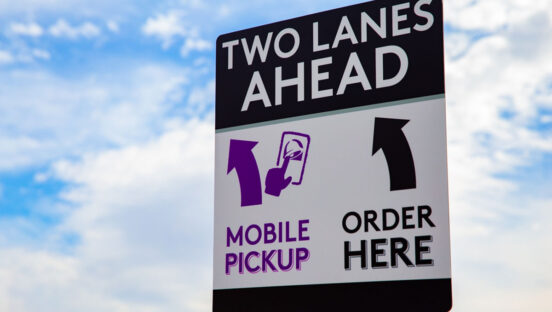Taco Bell has been busy lately, from unveiling self-serve kiosks to releasing of Nacho Fries to bolstering its leadership team—most notably hiring Julie Felss Masino as brand president—in just the last two months. And the brand is not stepping away from the spotlight anytime soon. “We’ll definitely be innovating more in 2018,” says Matt Prince, Taco Bell spokesperson.
In terms of what to look forward to, Prince says, “Fans will see familiar favorites with a fun twist, as well as completely new items. We’ll also continue the innovation off the menu—continuing to push culturally relevant moments and collaborations as we did in 2017 with Lyft, Forever 21 and OpenTable.” In July 2017, Taco Bell and Lyft unveiled the companies’ “Taco Mode” partnership, which allows Lyft customers to tack on a ride-thru at Taco Bell on the way to their destination of choice through Lyft’s app. Starting in October 2017, Taco Bell fans can now pick up the restaurant’s hot sauce–inspired apparel at Forever 21; and, also in October, Taco Bell partnered with OpenTable to open up reservations for a special National Taco Day dinner at the Taco Bell Test Kitchen.
“The primary factor at the root of our continued success is our innovative spirit,” Prince says. “Ever since Glen Bell entered the burger marketplace with tacos, Taco Bell has pushed innovation, accessibility, and affordability. We also lean into the passion and cult of our fans, connecting them with each other and their passions.”
In 2018, then, expect more partnerships capitalizing on the brand’s fandom in the vein of the 2017 Lyft, Forever 21, and OpenTable collaborations.
Keeping the brand agile, 2017 brought technology innovation to Taco Bell, an arena where, Prince says, the company will continue to focus efforts. “Our fantastic relationship with our franchisees has allowed Taco Bell to fund new technology initiatives for 2018 and beyond,” he says. With 2017’s digital efforts of expanded delivery, group ordering, and self-serve kiosks, Taco Bell is aiming to improve the customer experience with “frictionless digital experiences,” Prince says.
Taco Bell’s expansion last year, however, was not limited to the digital world. “2017 was a year that included a great deal of international expansion in Europe, China, and elsewhere, bringing our global total to over 400 restaurants in 26 countries,” which brings Taco Bell’s count today to around 7,000 restaurants, Prince says. Globally, the company hopes to grow to 9,000 restaurants over the next five years. And, in each new market, Taco Bell is bending and adapting as needed to fit local tastes, cultures, and preferences. In December, the company announced two new Shanghai, China restaurants, the menus of which feature a ribeye steak and mushroom taco, beef kebab nachos, and the Shanghai Cosmopolitan cocktail.
But don’t think that, with so much expansion elsewhere, Taco Bell would let its American menu stagnate. “We’re planning to roll out 20 new $1 test or limited-time-offer items through 2018 as part of our biggest value push in company history,” Prince says. “This begins with our highly anticipated $1 Nacho Fries [in January], and will include some fun takes on some our most popular menu items as well.”
“Whether it’s the unexpected flavors of the Naked Chicken Chalupa [the chicken-shelled menu item released in January 2017] or turning breakfast inside out with the Naked Egg Taco [fried egg is the taco shell here], Taco Bell takes fan feedback to heart and uses it to drive improvement and innovation,” Prince says. “We’ll continue to test menu items in select markets to gauge consumer reaction before we consider debuting them nationally.“
The Yum! Brands chain enjoyed a strong 2017 financially, reporting worldwide system sales growth of 6 percent in the third quarter versus the prior-year period. Yum! opened 70 Taco Bells in the quarter to bring its total count to 6,738. In the third quarter, the company debuted 15 new international units.







